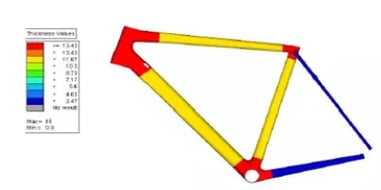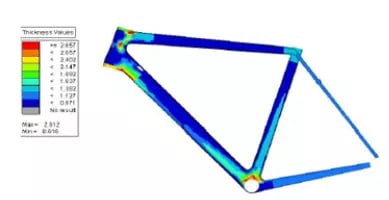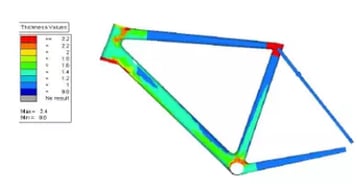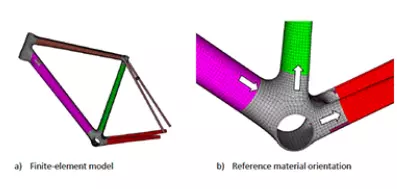Duratec
Development of a Lightweight, Composite Carbon Fiber Street Racing Bicycle Frame
About the Customer
Founded in 1992 by Milan Duchek, Czech company Duratec Ltd., was established as a result of his
enthusiasm for handmade bike parts. An innovative bike company, Duratec develops handmade
bike frames using both aluminum and composite materials. Rather than mass production, Duratec uses an custom approach by providing unique bike parameters for rider satisfaction. With an objective to develop the best possible bike suited to customer expectations, attention to detail is provided to obtaining correct size, frame geometry and optimized seat positioning.
Their Challenge
A recent project at Duratec was to apply their approach in development of carbon fiber optimization of the bike frame. The main objective of this project was to optimize a composite racing bike frame in order to obtain world-class performance. This entailed minimizing mass while maintaining or increasing stiffness and strength of the frame. Load cases used during optimization and results verification complied with European standard EN 14781 specifying the performance and safety measures requirements.
Our Solution
Using Altair HyperWorks™, the frame was optimized to minimize mass while improving stiffness and strength. Using HyperWorks for the entire process, the model was created in Altair HyperMesh™, optimized using Altair OptiStruct™ and the results evaluated using Altair HyperView™.
Stage-I: Free-Size Optimization – In this first stage the optimum shape & location of each
composite material layer was defined by creating ‘ply-patches’ of material with the same
fiber direction.
Stage-II: Size Optimization – During the ‘size optimization’ stage, the optimum thickness
of the ply-patches (created in Stage- I) were determined.
Stage-III: Shuffle Optimization – The final ‘shuffling’ stage evaluates the possible stacking
sequence of the composite layers and suggests the ideal order to meet the desired design
characteristics.
Several load cases were selected for the optimization studies to make sure the bike frame would meet all required criteria. For each load case, a constraint (allowable upper/lower limit value) was set. For the stiffness load cases (torsion/load transfer) displacement was a constraint, whereas
for strength load cases, the limit value was of Failure Index, which summarizes whether the composite will fail or not. Limit values varied and were dependent on the simulated load case. The limit value for the Failure Index was set to 0.7, which includes a certain safety factor (when Failure Index equals to 1, the composite fails).
Results
The new bike frame without painting, stickers, metal joints etc., with a mass of 590g was
developed. The ready-to-buy bike frame weighs in at 700g, a reduction of 28% from the
original weight of 980g.

Fig 1: Initial laminate thickness
 Fig 2: Laminate thickness after initial optimization
Fig 2: Laminate thickness after initial optimization
 Fig 3: Laminate thickness after second optimization
Fig 3: Laminate thickness after second optimization

“Next to our development, with the help of Advanced Engineering s.r.o., using the Altair
HyperWorks™ suite, our bike frame was optimized to minimize mass while improving stiffness and strength, resulting in a high-quality user experience for our customers.”
Milan Duchek, Founder and Owner, Duratec
